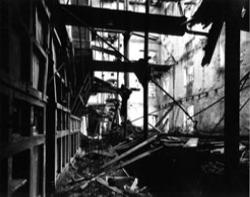 |
Luca Campigotto
An archaeology of feelings
The old Mill has always been a stranger in Venice. In the mists of winter this great foreign construction can even transform the Giudecca into a North Sea island.
Since I was a child, almost without knowing its history, I have always loved it instinctively with that particular kind of affection which binds you to things which feel close but never actually belong to you.
Even now, when I look at this gigantic building, I think of the small mill in the countryside my grandfather had in the war years. Tracing back my father’s nostalgia, I even feel an inexplicable sense of loss for something which in reality has never been part of my past, to the point where I lay bare part of my own personal nostalgia.
I don’t know what my grandfather thought of the Molino Stucky. His mill had a two horsepower engine and he had the strength - the superhuman strength typical of the heroes of our private ancestries - to bring it to a halt by grasping the driving belts when something (to be honest, I never understood exactly what) jammed up and the wheat spilled all over the place.
I remember that he had little splinters of stone from the millstone embedded in his hands, and that when Mussolini announced Italy’s declaration of war his comment was: ”bravo mona” (well done, idiot). Probably because he foresaw that before long the Germans would turn up at the threshing floor of the mill to commandeer his flour.
At the Molino Stucky I am certain that everything ran smoothly using the best technology of its time. The design of the building was inspired by similar constructions in Northern Europe. The German machinery was of the utmost reliability and the technicians who came to assemble it were foreign too.
In the yellowing old photographs the quay opposite is crowded with ships. All this had to do with distance, travel, absence.
Unlike San Marco, which was always too beautiful to be considered as a possession, the Mill at the far end of the Giudecca (almost at Sacca Fisola, the only place in Venice where the houses are the same as those on the mainland) was always a no man’s land.
We used to circle around it in a friend’s small boat, trying to find a grating which could easily be prised open, dying with curiosity to see what was inside.
Every forbidden place creates a deep longing. These are the torments of adolescence, of exploration, of having to see for oneself. And I, pathetically, would have liked to bear the scars of wounds inflicted by the impenetrable brambles. I would have braved tetanus and the collapse of the ceilings.
At that time I never even imagined that, before long, the Mill would have played a new part as the backdrop to romantic walks. Even better that roaming round the “sconte”, the less frequented alleys of central Venice, a trip to the Stucky was like a miniature journey. Anyone who has been young in Venice knows just what it means. Wandering round the Giudecca – like going to the beach on the Lido in winter – is the little adventure in a day which sets out to be different.
Then, a few years later, I discovered Piranesi and the claustrophobic anxiety of his prison fantasies.
It was at an exhibition at the Cini Foundation and I remember that – as I emerged into the bright outdoor light on the wonderful floating platform of the Riva di San Giorgio – I looked at the Stucky and reflected that in there, in the dark, an entire unknown world was silently vegetating. Rooms, machinery, furniture. All suffocated in a green wilderness. Abandoned and, most probably, already abundantly plundered.
I adore Piranesi’s vision, because from a broad view he leads you into the black bowels of architecture.
His strokes are precise and clear-cut. His images are totally in focus. And yet, to the eyes of the viewer the space is so complicated that it becomes inextricable. Grandiose crepuscular mise-en-scènes, like the interior of the ruined Stucky. Architecture transmuted into catastrophe, while remaining fatally seductive. An industrial locus plucked from the dark atmospheres of visionary cinema. These scenes are born of the art of rearranging images, of imagining future spaces which echo the settings of past times. They arouse a sense of melancholy bound up with the design of objects, overcoats, the light which slants in through shutters, ceiling fans. As though by means of memories, precariously poised between the true and the probable, it were always possible to go back and open any door of history.
Working on one’s own past – regaining it, or even just recording it in photographs – is difficult because it leads you to disperse mysteries to which you are profoundly attached, in one way or another. But how can you resist the temptation to explore a world which for years you have imagined from the outside?
Revealing a spell is always dangerous: but the desire to know, whatever the outcome, is in the end more important. And so taking photographs is also only a means, a means like any other of expressing interest, curiosity, attraction. In the hope of leaving a sign which can be recognized as an act of love.
from Molino Stucky, Marsilio, 1998